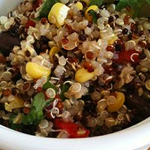Nan Jensen RD, LD/N
Extension Agent
September is Whole Grains Month and a perfect time to jump on the whole grains bandwagon. Health experts advise us to make at least half our grains we put on our plate “whole grains.” These would include grains like wheat, corn, rice, oats, barley, quinoa, sorghum, spelt, rye – when these foods are eaten in their “whole” form.
Health Benefits
Whole grains are a valuable source of B vitamins, vitamin E, magnesium, iron and fiber. Because of the phytochemicals and antioxidants, people who eat three daily servings of whole grains have been shown to reduce their risk of heart disease by 25-36%, stroke by 37%, type II diabetes by 21-27%, digestive system cancers by 21-43%, and hormone-related cancers by 10-40%.*http://wholegrainscouncil.org/whole-grains-101/health-studies
Shopping for Whole Grains
To help you locate whole grain products in the supermarket, look for “the Whole Grain Stamp”. According to the Whole Grains Council, there are two different varieties of the Whole Grain Stamp, the 100% Stamp and the Basic Stamp.
• If a product bears the 100% Stamp, then all its grain ingredients are whole grains. There is a minimum requirement of 16g (16 grams) – a full serving – of whole grain per labeled serving, for products using the 100% Stamp.
• If a product bears the Basic Stamp, it contains at least 8g (8 grams) – a half serving – of whole grain, but may also contain some refined grain. Even if a product contains large amounts of whole grain (23g, 37g, 41g, etc.), it will use the Basic Stamp if it also contains extra bran, germ, or refined flour.

Cooking Whole Grains
Looking for some help to get you started? Cooking and Eating Whole Grains is a quick guide that outlines how to cook everything from amaranth to wild rice.
For some great recipes ideas, click on whole grain recipes
 0
0
